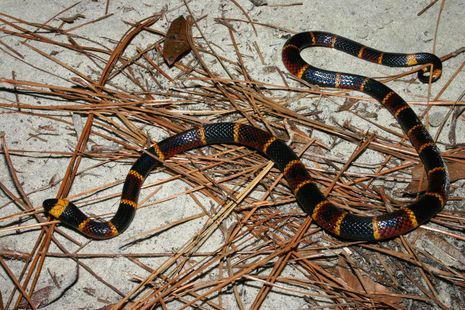Learning from mimicry
Lucie Gourmet explores how mimicry arises in nature, the lessons we have learnt from it, and how mimicry may influence robotics

Mimicry is the art of copying, which is innate to humans. It occurs when infants who hear someone crying will start crying as well, or when you unconsciously imitate someone else’s accent. This behaviour is intriguing as you may ask yourself: what benefit do I obtain by repeating the same action as someone else? This ability is not unique to humans, but we learned to exploit it in different ways.
Nature mimicking nature
In evolutionary biology, mimicry can be defined as a physical appearance adaptation that promotes survival by either increasing the number of offspring or deterring predators. It is found across the tree of life, presenting a wide range of different types, but is especially interesting in butterflies. Batesian mimicry is when a harmless species mimics a harmful one, such as Consul Fabius mimicking Heliconius butterflies. This theory was named after Henry Walter Bates because of his studies on butterflies in the Amazon rainforest. In contrast, Müllerian mimicry is when multiple species present themselves as harmful: in this way, when a common predator confuses both species, they are more likely to survive. For example, Danaus plexippus and Limenitis Archippus butterflies are unpalatable to predators, which protects them.
A less common type of mimicry is Emsleyan mimicry, where a predator mimics prey to lure potential predators. Snakes are an example of this, with the deadly coral snake resembling the harmless milk snake and the moderately venomous false coral snake. All these species have red, yellow and black stripes, but the false coral snake is considered the original, whilst the others are the mimics. Appearing similar to a dangerous species could strongly deter potential attackers.
Mimicry also exists in plants and can be separated into two groups: mimicry which provides protection against herbivores and mimicry which involves getting rewards from pollinators without giving anything back in return. Batesian mimicry is present in plants such as Aloe vera, which develop thorn-like imprints to deter animals that may try to feed on them. Types of mimicry specific to plants include Dodsonian mimicry, where reproductive floral mimicry can lure pollinators. Pouyannian mimicry is similar but, in this case, plants resemble insects. Fascinating flowers such as the fly orchid and the bee orchid can lure male insects to transfer pollen.
“Humans are known to be inspired by nature”
Biomimetics and how we exploit nature
Humans are famously inspired by nature, as the sketches of Leonardo Da Vinci’s flying machines testify. There are multiple examples of animals studied to create new technologies. For instance, cats gave us the idea to put light reflectors called “reflective cat eyes” on the side of the road to ensure road safety at night. In the 1930s, Percy Shaw was driving during the night on poorly lit country roads while a cat jumped on a fence. The eyes of the cat reflected his headlights and saved his life as he realised he was driving on the wrong side of the road. Thanks to the cat, he avoided an accident and developed an invention that improved road safety.
The kingfisher is known to have inspired the design of the high-speed train Shinkansen in Japan. Trains used to be a nuisance to the environment, as they produced noise when passing in tunnels until the bill of kingfishers inspired a more aerodynamic nose shape. Interestingly, the kingfishers’ lower retractable eyelids protecting their eyeball when diving helped develop another technology. Engineers copied this design to help prevent soil erosion on the banks of the Three Gorges Dam in China. Like the eyelid, the device can be retracted when the water level decreases, which prevents damage to the ecosystem.
Whilst they are unpopular, spiders have inspired multiple inventions, such as creating glass with UV-reflective coating to avoid the death of birds that fly directly into windows. This idea came from the realisation that birds tend to avoid windows with spider webs, as these can reflect UV light. Spider webs could also aid us to detect earth vibrations via remote sensing. Additionally, in robotics, cartwheeling spiders inspired robot motility, leading to the development of robots capable of going through dunes.
“The aim is not to copy nature but rather to identify mechanisms that can help solve a problem”
Point of view of an expert
I interviewed Prof Fumiya Iida, a researcher in bio-inspired robotics at Cambridge, and he explained that his passion for mechanical engineering stems from analysing the fundamental differences between animals and machines. Biological organisms are a product of evolution, years of trial and error, unlike machines made by us. Evolution is not always better than the machines we build, as we can optimise particular processes. Biomimetics begins by observing nature and extracting patterns from it. The aim is not to copy nature but rather to identify mechanisms that can help solve a problem. Bio-inspired technologies are interdisciplinary and lead to a wide range of applications from the military to medicine. He is particularly interested in leg locomotion as it is a complex problem for machines, which usually use wheels instead. He developed various systems, including unconventional clutch-based actuators, energy-efficient legged locomotion based on parallel elastic mechanisms and assistive mechatronic posture support. We can walk easily with the soft and rigid tissues we are made of, but robots are mainly composed of hard structures, which presents challenges to maintaining balance and moving smoothly.
With the progress of research and state-of-the-art technologies, we can wonder if robots will be indistinguishable from humans one day. For Dr Fumiya Iida, the combination of the humanisation of robots and the mechanisation of humans could eventually lead to this result. Ethical regulations are crucial in ensuring artificial intelligence do not us to our extinction. Biomimetics enables us to learn about nature and makes us aware of our fate as a species.
 Arts / Why Cambridge’s architecture never lives up to the ‘dark academia’ dream 17 October 2025
Arts / Why Cambridge’s architecture never lives up to the ‘dark academia’ dream 17 October 2025 Lifestyle / My third year bucket list17 October 2025
Lifestyle / My third year bucket list17 October 2025 News / How much does your college master earn?17 October 2025
News / How much does your college master earn?17 October 2025 Sport / Between ambition and responsibility: Cambridge United and the future of lower-league football17 October 2025
Sport / Between ambition and responsibility: Cambridge United and the future of lower-league football17 October 2025 News / University submits plans to build 3,800 new homes19 October 2025
News / University submits plans to build 3,800 new homes19 October 2025










